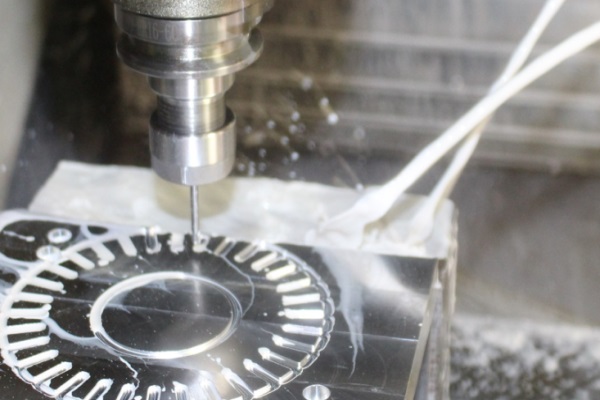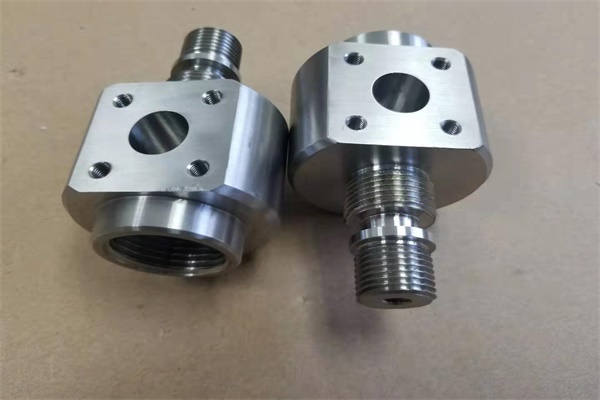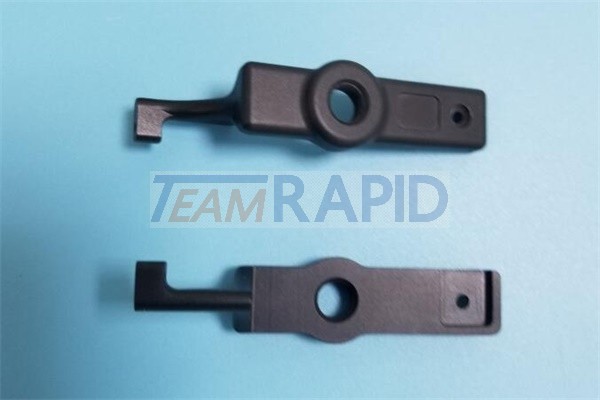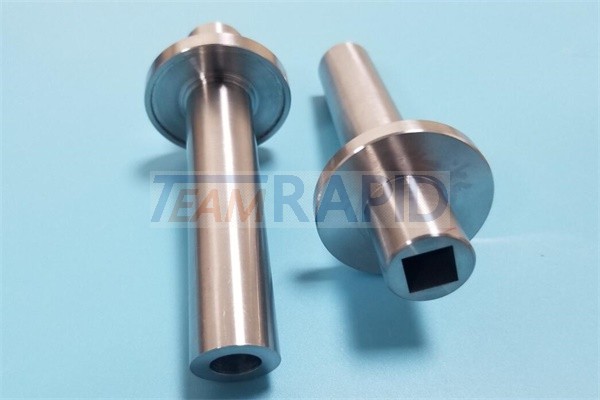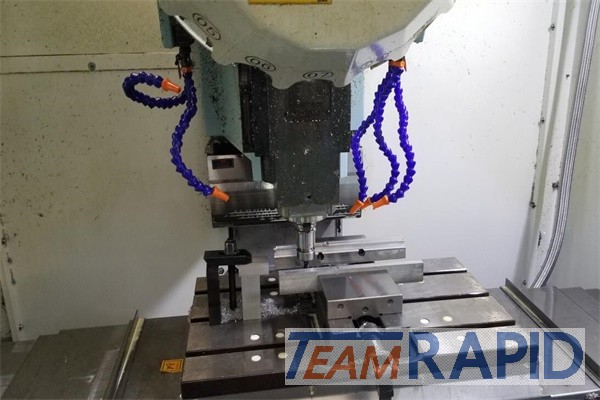Are you looking for a reliable, fast supplier of plastic or metal CNC parts? With a series of CNC machines at our manufacturing facilities, we have unparalleled capacity so we can always deliver on time. TEAM Rapid machining centers are designed for rapid manufacturing and low-volume production of end-use components.
Table of Contents
- 1 What is CNC machining?
- 2 What is the CNC machining process like?
- 3 what does CNC machining do–which type of component is generally suitable for CNC machining
- 4 Criterion manufacturing time vs. information on technical drawings
- 5 CNC machining method
- 6 Advantages of the CNC machining
- 7 The difference between conventional milling
- 8 Why choose TEAM Rapid for CNC Machining?
What is CNC machining?
“CNC” is the official abbreviation for “Computerized Numerical Control”. Behind this futuristic term, there is a long history, which still describes the core of the development of computer-controlled machine tools. The established method of CNC machining includes the production of geometrically complex components with the support of special machines, which automatically implement the previously programmed specifications with high precision.
The principle and function of CNC machining
The numerical control is in addition to the human component in CNC machining the factor that is probably the most important. These powerful helpers are three or five-axis milling machines that run through fully automated programs and produce a component. Depending on the desired component, the work steps defined in the routine include the removal of material that is not required or the production of a thread while maintaining the applicable standards.
The production of an object is based on 3D objects, which first have to be transmitted to the machine via a computer. As the process progresses, skilled workers must, for example, check both cutting speed and feed rate against the CNC computer calculations before manufacturing according to plan can take place.
What is the CNC machining process like?
1. Prepare semi-finished products
Raw material, so-called semi-finished products, is required for CNC machining. These are mainly bars for turning and saw cuts in the form of plates for milling.
Depending on the quantity, material, and size, the semi-finished products are either cut to size in our factory or purchased from an external material dealer.
2. Set up the CNC machine
Setting up the CNC machine is a basic requirement for CNC machining. To be able to produce CNC parts, the clamping of the semi-finished products and the tools such as milling cutters, drills, lathe tools, etc. must be prepared. The choice of clamping is mainly made depending on the geometry of the semi-finished product and the contour of the finished part to be achieved. Other factors are the machining paths of the tools on the workpiece in the machine and the forces expected during machining.
In the case of complex components in particular, for example, during milling, it may be necessary to prepare special clamping jaws beforehand. This requires a lot of experience and good preparation. The geometry of the turning or milling tools can be measured either with a tool presetting device or directly in the machine.
3. Program CNC machine
The machining program, the so-called NC program, specifies how a finished CNC part is produced from the semi-finished product using the prepared tools. Depending on the complexity, the time required for programming varies between a few minutes and several hours. Editor programs and CAM software (Computer Aided Manufacturing software) can help to significantly speed up and simplify the programming effort. Every work step can be programmed digitally with the help of a 3D model.
Learn more about programming!
4. Adjusting the CNC machine
After the CNC program has been created and read in by the machine, the first component can be manufactured. Here, the NC program is run for the first time under the supervision of an employee. Any errors in the program can be corrected or corrections can be made, for example with drilling depths.
5. Production release through quality inspection
After the production of the first component, the dimensions are checked using the technical drawing. For this purpose, various common measuring and test equipment as well as different measuring machines are used in our measuring room.
6. Manufacture CNC parts
When all the preparation work steps have been successfully completed, the production of the CNC parts begins. The production time of the components is determined by various factors. Essentially, the material determines the time required for machining. The requirement for a certain surface quality also influences the production time.
what does CNC machining do–which type of component is generally suitable for CNC machining
The processes of milling and turning are very flexible CNC manufacturing processes with great freedom of design of the components. Especially in metalworking, these are used from prototypes to large series.
Surface quality criterion
Typical mean roughness values for CNC machining are in the range of Ra 0.8-3.2 µm. Values smaller than Ra 0.8 µm are also possible.
The following factors have an influence on the surface roughness: cutting values during machining, cutting material and its cutting geometry and state of wear, machining properties of the material, and use of cooling lubrication. Compared to 3D printing, which is also becoming more relevant for small batch sizes, significantly higher surface qualities can be achieved with machining. Untreated “unfinished” surfaces in 3D printing amount to about Ra 6-15 µm, depending on the process.
Criterion quantity
Contrary to many assumptions, CNC machining can be economical even for small to medium-sized quantities. For small to medium quantities, 1-1,000 pieces are usually meant. Basically, since the machine has to be set up once at the beginning of production, the costs per CNC part decrease as the number of pieces increases. The one-time set-up of a CNC machine for manufacturing processes in the field of machining is compared, for example, with forming processes such as casting significantly lower. This means that small batch sizes and individual parts for prototypes in particular can be manufactured economically. Depending on the material and geometry of the components, CNC machining can also be an economical option for larger quantities.
Criterion manufacturing time vs. information on technical drawings
The motto time is money also applies to CNC machining. Tolerances and surface quality should always be selected by TEAM Rapid’s designer only as tightly as is really necessary to achieve cost-effective production. At the end of the day, who needs an adapter plate with a glossy, smooth, and beautiful surface when the component disappears into a machine at the end of the assembly and only fulfills its function? Of course, we manufacture the components as you wish, but we are also happy to advise you on the selection of tolerances and surface quality.
Criterion Accuracy
One of the biggest pluses of CNC machining is precision. Geometric deviations that can be achieved are in the range of a few micrometers. This means that CNC machining is clearly superior to other manufacturing processes, for example when it comes to milling and turning. The CNC parts can therefore be used without problems in areas where precise alignment within an assembly is required.
criterion material
Various metals are suitable for CNC machining, such as aluminum, steel, stainless steel, and brass, but also high-strength plastics. In principle, a large number of materials can be used, but it is also important to note here: The harder the material, the higher the tool wear and the lower the material removal rate.
CNC machining method
Manufacture CNC milled parts
Milling is a machining manufacturing process of a mostly multi-toothed tool. In contrast to turning, the milling manufacturing process can also be used to produce non-rotationally symmetrical workpieces. With CNC milling, the tool rotates and the workpiece is firmly fixed in a fixture. The different types of milling machines are divided into 3-axis, 4-axis, and 5-axis machining centers depending on their movement options. Depending on the direction of rotation of the milling cutter, a distinction is made between down milling and up milling. The milling processes are designated according to the workpiece geometry to be produced.
Manufacture CNC turned parts
Turning is a cutting manufacturing process for the production of rotationally symmetrical components. The workpiece made of machinable material clamped in the lathe performs the circular cutting movement, while the tool performs the necessary feed and infeed movements. The workpiece thus represents the body of revolution. Through this process, the material is removed from the workpiece by the tool.
Turning methods are classified as follows:
– Depending on the position of the surface in external and internal turning
– Depending on the feed direction in transverse and longitudinal turning
Depending on the machining surface, this classification can also be further differentiated into, for example, face turning, cylindrical turning, profile turning, or similar.
The range of applications for CNC-turned parts is diverse. It ranges from rotationally symmetrical components for automation technology, hydraulics, pneumatics, and mechanical and plant engineering to the smallest CNC-turned parts for medical technology and electrical engineering.
Advantages of the CNC machining
CNC machining offers many advantages over conventional machines:
It also allows the machining of complex shapes (3D),
works economically,
is very precise and can repeat steps exactly and
proceeds very quickly;
Since programs can be stored, many of the same parts can be mass-produced without the need for personnel;
Last but not least, CNC technology can be used to develop new concepts for machines because it does not require a connection between the main drive and the feed drive.
The difference between conventional milling
CNC milling is generally distinguished from conventional milling, which is controlled manually or mechanically. In contrast to CNC milling, the feeds are regulated either by cranks or simple feed devices. The scales with verniers show which dimensions are used. Almost all milling machines that are used productively now work with optoelectronic path measuring systems, i.e. processes that allow the conversion of electronically produced data and energy into light emission and vice versa. The tools are exchanged by hand.
Why choose TEAM Rapid for CNC Machining?
Fast, reliable delivery
Test and change part designs in rapid succession and accelerate product development with express parts. Our automated design analysis helps identify difficult-to-machine elements before sending your design to manufacturing. This avoids costly rework later in the product development cycle.
Feedback on the feasibility of the design
When you request a quote by uploading your 3D CAD file, we analyze the part geometry to identify hard-to-machine features. Examples are tall, thin walls or holes that cannot accept threads.
Material selection
We stock more than 30 engineering metal and plastic materials suitable for various part applications and industries. The choice of materials ranges from plastics such as ABS, polycarbonate, polyamide, and aluminum, stainless steel, magnesium, and copper.
Flexible CNC lead time
From now on you can choose the CNC lead time flexibly and thus determine the delivery date and the costs for your CNC parts yourself.
With a lead time of between 7 and 14 days, we can offer you a lower price as part of our flexible manufacturing option – but you will still receive your parts significantly faster than with most other suppliers.
